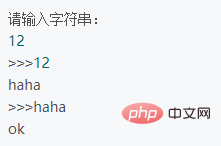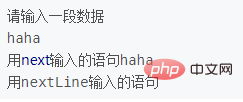How to let Java get the string entered by the user

It is a very common operation to dynamically input data from the console, perform various processing on the data, and then output the data. Now we will give a systematic introduction to the data input method:
Call of Scanner class
Related methods:
hasNext() Determine whether there is the next paragraph after the current scanning position in the scanner.
hasNextLine()Returns true if another line exists in this scanner's input.
next()Find and return the next complete token from this scanner.
nextLine()This scanner executes the current line and returns skipped input information.
nextInt()Return the integer data scanned by the console.
Related video tutorial sharing: java learning video
Code example:
package FIRST_Chapter;
import java.util.Scanner;
public class TestScanner {
public static void main(String[] args) {
Scanner s = new Scanner(System.in);
System.out.println("请输入字符串:");
while (true) {
String line = s.nextLine();
if (line.equals("ok")) break;
System.out.println(">>>" + line);
}
}
}Result demonstration:

The difference between next() and nextLine() methods
next() method must read valid characters before it can end the input. Valid characters must be entered The next() method will automatically remove the previously encountered terminators such as the space bar, Tab key or Enter key. Only after entering a valid character, the next() method will remove the space bar, Tab key or Enter key entered afterwards. Keys, etc. are treated as delimiters or terminators.
Simply put, next() finds and returns the next complete token from this scanner. The complete tag is preceded and followed by input information that matches the delimited pattern, so the next method cannot get a string with spaces.
The end character of the nextLine() method is only the Enter key, that is, the nextLine() method returns all the characters before the Enter key, and it can get a string with spaces.
For example, the following program:
package FIRST_Chapter;
import java.util.Scanner;
class test{
public static void main(String[] Args){
Scanner sc= new Scanner(System.in);
System.out.println("请输入一段数据");
String str =sc.next();
System.out.println("用next输入的语句"+str);
String str1 =sc.nextLine();
System.out.println("用nextLine输入的语句"+str1);
//sc.nextLine();//如果下面注释行想用nextLine的话,就要注意加上这句话
}
}Output result:


The above is the detailed content of How to let Java get the string entered by the user. For more information, please follow other related articles on the PHP Chinese website!

Hot AI Tools

Undresser.AI Undress
AI-powered app for creating realistic nude photos

AI Clothes Remover
Online AI tool for removing clothes from photos.

Undress AI Tool
Undress images for free

Clothoff.io
AI clothes remover

AI Hentai Generator
Generate AI Hentai for free.

Hot Article

Hot Tools

Notepad++7.3.1
Easy-to-use and free code editor

SublimeText3 Chinese version
Chinese version, very easy to use

Zend Studio 13.0.1
Powerful PHP integrated development environment

Dreamweaver CS6
Visual web development tools

SublimeText3 Mac version
God-level code editing software (SublimeText3)

Hot Topics
 Square Root in Java
Aug 30, 2024 pm 04:26 PM
Square Root in Java
Aug 30, 2024 pm 04:26 PM
Guide to Square Root in Java. Here we discuss how Square Root works in Java with example and its code implementation respectively.
 Perfect Number in Java
Aug 30, 2024 pm 04:28 PM
Perfect Number in Java
Aug 30, 2024 pm 04:28 PM
Guide to Perfect Number in Java. Here we discuss the Definition, How to check Perfect number in Java?, examples with code implementation.
 Random Number Generator in Java
Aug 30, 2024 pm 04:27 PM
Random Number Generator in Java
Aug 30, 2024 pm 04:27 PM
Guide to Random Number Generator in Java. Here we discuss Functions in Java with examples and two different Generators with ther examples.
 Armstrong Number in Java
Aug 30, 2024 pm 04:26 PM
Armstrong Number in Java
Aug 30, 2024 pm 04:26 PM
Guide to the Armstrong Number in Java. Here we discuss an introduction to Armstrong's number in java along with some of the code.
 Weka in Java
Aug 30, 2024 pm 04:28 PM
Weka in Java
Aug 30, 2024 pm 04:28 PM
Guide to Weka in Java. Here we discuss the Introduction, how to use weka java, the type of platform, and advantages with examples.
 Smith Number in Java
Aug 30, 2024 pm 04:28 PM
Smith Number in Java
Aug 30, 2024 pm 04:28 PM
Guide to Smith Number in Java. Here we discuss the Definition, How to check smith number in Java? example with code implementation.
 Java Spring Interview Questions
Aug 30, 2024 pm 04:29 PM
Java Spring Interview Questions
Aug 30, 2024 pm 04:29 PM
In this article, we have kept the most asked Java Spring Interview Questions with their detailed answers. So that you can crack the interview.
 Break or return from Java 8 stream forEach?
Feb 07, 2025 pm 12:09 PM
Break or return from Java 8 stream forEach?
Feb 07, 2025 pm 12:09 PM
Java 8 introduces the Stream API, providing a powerful and expressive way to process data collections. However, a common question when using Stream is: How to break or return from a forEach operation? Traditional loops allow for early interruption or return, but Stream's forEach method does not directly support this method. This article will explain the reasons and explore alternative methods for implementing premature termination in Stream processing systems. Further reading: Java Stream API improvements Understand Stream forEach The forEach method is a terminal operation that performs one operation on each element in the Stream. Its design intention is






